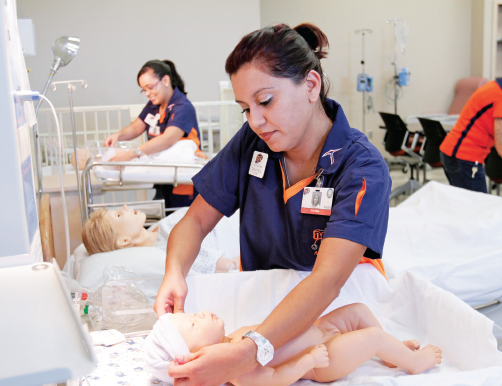As Texas faces a shortage of 71,000 nurses by 2020, The University of Texas at El Paso School of Nursing is spearheading an innovative program to accelerate training for future registered nurses, thanks to a nearly $4 million grant awarded in spring 2012 by the U.S. Department of Labor.
The four-year grant will create the Successful Transition and Retention (STaR) Program, a new graduate nurse residency program at UTEP, the Texas Tech University Health Sciences Center Gayle Greve Hunt School of Nursing, and The University of Texas at Austin School of Nursing, that will provide education, training and job placement assistance for graduates at eight Texas hospitals owned by the Hospital Corporation of America (HCA).

Center for Simulation to practice their skills before working with patients.
“This award illustrates our commitment to our clinical partners and to the other schools of nursing in this great state of Texas,” said UTEP School of Nursing Dean Elias Provencio-Vasquez, Ph.D., the grant’s principal investigator. “It’s a new way of educating the next generation of nurses to be aligned with the changing health care system.”
Through STaR’s New Graduate Nurse Immersion Residency, new graduates will receive on-the-job training at Del Sol Medical Center and Las Palmas Medical Center in El Paso and at six Central Texas hospitals that are part of St. David’s HealthCare. The program is designed to accelerate the orientation of new nurses by helping them transition to the role of bedside nurses in a quality, efficient and cost-effective manner.
Once their immersion is complete, graduates will continue on to the Specialty Nurse Accelerated Program Fellowship, where they will receive intensive training in their specialty field.
According to Provencio-Vasquez, hospital orientation for new nurses typically takes 10 to 12 weeks. During that time, they shadow experienced nurses and become immersed in the hospital’s culture, procedures and policies. It can take up to three months before new nurses start caring for patients on their own. The STaR program is expected to shorten that training period and create a win-win situation for nursing schools and their clinical partners.
“The hospital partners will benefit from the collaboration with the academic partners in terms of curricula development and instructors,” said Bonnie Clipper, associate vice president of professional practice and development at St. David’s HealthCare. “The academic partners will benefit by developing innovative content and strengthening relationships with the hospitals.”
Grant money will be used to develop content specific to the needs of the nurse residency programs, build simulation scenarios, provide textbooks and university instructor time for building and delivering content to new nurses in residency and fellowship programs, and provide a minor salary offset for the residency program, Clipper said.
“This grant validates UTEP’s determination to implement innovative solutions to address the nursing shortage in our community and nationally,” said UTEP President Diana Natalicio. “UTEP is committed to providing our students with preparation that aligns well with the changing health care landscape and ensures the success of the graduates of our nursing programs.”
The program is expected to enroll up to 54 nurses per year. UTEP students who will benefit from the program will be in their eighth or final semester of nursing school, like Lyndsey Slape, who was considering a specialty in the neonatal intensive care unit or the critical care unit after graduating from UTEP in May.
Slape said she would have considered applying to the program had it been available to her.
“It provides a great opportunity for students to get the experience of hands-on training,” she said. “You get training through the nursing school and sim[ulation] lab, but it’s different being in the hospital.”
The UTEP School of Nursing was ranked the top nursing school for awarding bachelor’s degrees to Hispanics in the United States in 2011. In spring 2012, the school enrolled approximately 1,700 students in its bachelor’s, master’s and Doctor of Nursing Practice degree programs. School officials estimated that 60 percent of the nursing staff at El Paso hospitals and civilian nurses at William Beaumont Army Medical Center are UTEP graduates.
The award is part of $183 million in grants awarded in March by the Department of Labor to 43 public-private partnerships serving 28 states. The grants provide education, training and job placement assistance related to high-growth fields in which employers are currently using the H-1B nonimmigrant visa program to hire foreign workers.
The Bureau of Labor and Statistics projects that between 2008 and 2018, the biggest increase in job growth will occur in registered nurses, with 581,500 new jobs expected. This represents almost 200 additional nurses at Del Sol Medical Center and Las Palmas Medical Center and almost 500 for St. David’s HealthCare and its six hospitals in the Austin area, according to the grant proposal.
“Our graduates are a significant part of health care in El Paso and the rest of the region,” Provencio-Vasquez said. “UTEP graduates the best and the brightest nurses who are changing the way health care is delivered in our community.”